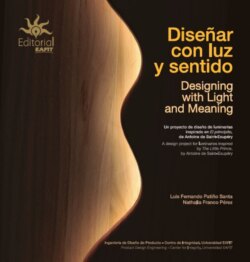Читать книгу Diseñar con luz y sentido - Luis Fernando Patiño Santa - Страница 6
На сайте Литреса книга снята с продажи.
ОглавлениеPrologue
When an atom is observed, it appears in space as a particle, and when the observer moves away, it disappears. It is a matter of quantum physics. This is what good projects are like: they appear when several people begin to think about them and dedicate their energy and motivation to them and continue if there is perseverance and profound dedication. In this case, the luminaires inspired by The Little Prince presented in this book and created through a design exercise in the Project 2 course, are imbued with values, knowledge, techniques and the love of one’s work. It is an unexpected, fresh and creative exercise for new generations who want to learn in a different way.
This book is the materialization of an encounter between two ideas: the first is how to teach design by motivating the students to learn, and the other is how to reflect on integrity in classrooms by designing with meaning. It is the testimony of an unforgettable exercise because it was engraved into hearts of those who participated in it. It reached our core, it pierced our hearts and will always be remembered as a great challenge for the Product Design Engineering (PDE) professors, the students, and the people who collaborated. It was essential to tell this story, so that it would remain as an academic testimony of how to innovate in the classroom and how to unite product design and integrity in a freshman year course in a challenging major such as PDE.
Thus, this book is a travel log that narrates how the exercise began, how it was developed and what the results were. The introduction explains which departments at Universidad EAFIT participated in the project and why they coordinated their efforts to give it life. Chapter 1 describes what is meant by designing with meaning, from a universal inspiration and with something as immaterial as light. Chapter 2 narrates the development of the exercise, its pedagogical strategy, and the most important findings. Finally, the conclusions reflect on the process from the standpoint of integrity and results presented by the students. The book concludes with photographs of the luminaries as a catalog.
The design process is infinite, and you can always innovate by proposing new challenges. We hope that this book will be a source of inspiration to anyone who holds and examines it, skims through it, or reads it carefully. It is an invitation to enter the world of creativity, design and humanity. It is a point of inflection to return to the understanding that “what is essential is invisible to the eyes.”
